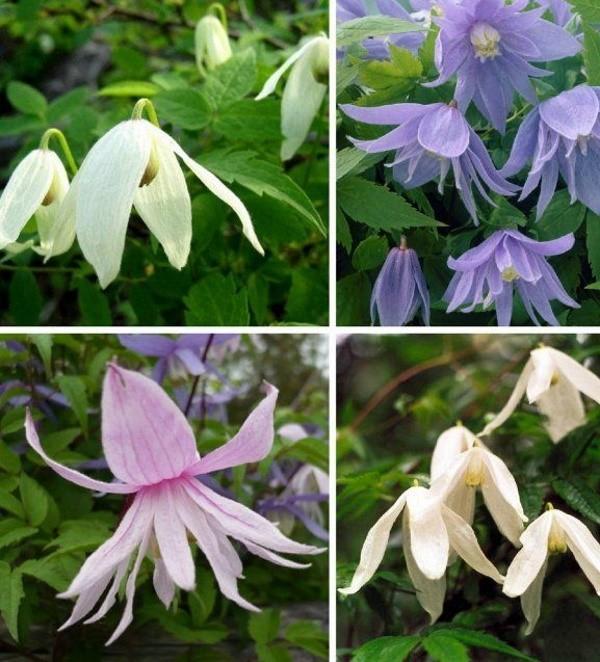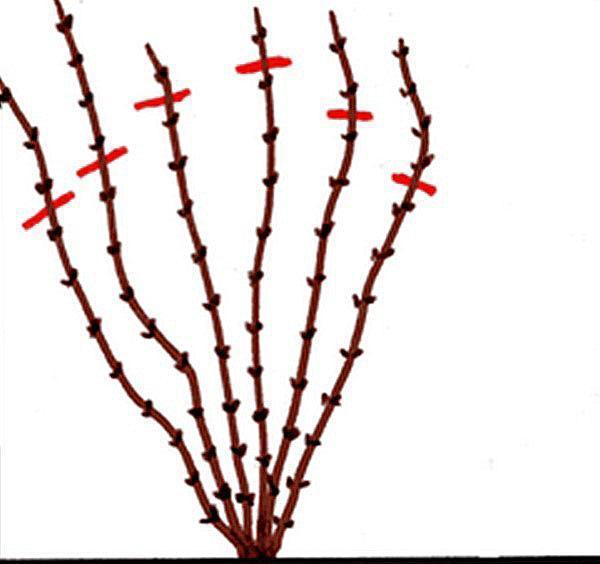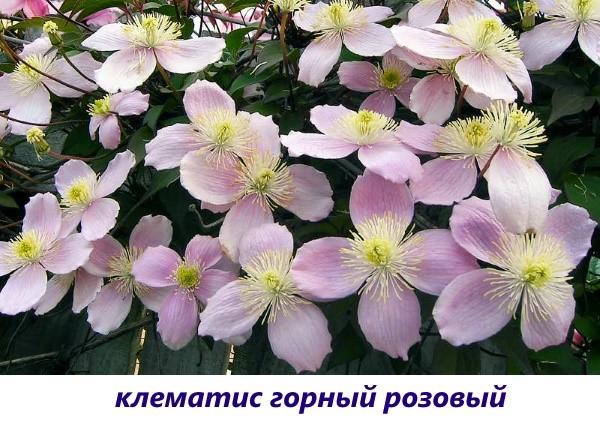Abundantly flowering vines on your site - clematis of the first pruning group with a photo and a short description
 Clematis of the first pruning group is one of the most unpretentious plants in terms of cutting. It is a pleasure to look after them: planted, installed a support and water and tie yourself up from time to time, but there is no need to constantly jump around the bush with a pruner.
Clematis of the first pruning group is one of the most unpretentious plants in terms of cutting. It is a pleasure to look after them: planted, installed a support and water and tie yourself up from time to time, but there is no need to constantly jump around the bush with a pruner.
Read also the article:Tatar honeysuckle - plant description!
Group characteristics

Naturally, when growing such varieties, the age of the plant should also be taken into account. If necessary, the bushes are subject to a rejuvenating haircut, because if they are too thick, this will affect the quality of flowering.
Rejuvenation is carried out in the summer, completely cutting out the old branches approximately every two years.
It is impossible to describe the varieties of the group in one word, there are among them both very large species and quite suitable shrubs for home growing. However, all of them are characterized by abundant flowering: a huge set of buds "sit" close to each other, creating a spectacular colorful wall. Although clematis will not surprise with the special sizes of inflorescences, such a large number of flowers makes you forget about their size.
Today we want to bring to your attention the most popular and most beautiful varieties. clematis from the first trimming group. So, let's begin.
Clematis mountain pink
 One of the tallest species is the mountain pink clematis or Montana (as it is also called). It grows on average up to 8 m in height, and in the southern regions the lashes can stretch up to 12 m.Opposite leaves of a dark green color are located along the entire length of the shoots, the length of which does not exceed 10 cm.
One of the tallest species is the mountain pink clematis or Montana (as it is also called). It grows on average up to 8 m in height, and in the southern regions the lashes can stretch up to 12 m.Opposite leaves of a dark green color are located along the entire length of the shoots, the length of which does not exceed 10 cm.
From May to July, the bush is literally strewn with not very large, up to 5 cm in diameter, inflorescences of white-pink color with a delicate vanilla aroma. They have only 4 petals, but they are very wide, they can be either single or collected in small groups of 3 to 5 buds. At first, the inflorescences are saturated in color, but gradually they seem to fade and brighten.
After the end of flowering in the current season, you need to slightly shorten the lashes.
Many hybrid varieties have been created on the basis of mountain pink clematis, among them the most popular are:
- Grandiflora (characterized by active weaving, fast growth and white flowers);

- Rubens with pale pink inflorescences.

The variety has low frost resistance. When the temperature drops below 20 degrees of frost, shoots and flower buds freeze slightly, therefore, mountain pink clematis is most often grown in the southern regions.
Clematis of the Atragene group
One of the simple but charming clematis of the first pruning group is the Atragene group. They are made into a separate genus and are very popular among gardeners due to their simplicity in cultivation and the modest size of the vines, for which they even received the affectionate nickname "princes".
For clematis of the Atragene group, the following signs are characteristic:
- early and abundant but short flowering;
- the ability to grow in the shade;
- high resistance to diseases and low temperatures;
- minimal care (without pruning, without removing shoots and shelter for the winter);
- decorative appearance after flowering due to beautiful seed bolls;
- all varieties are good honey plants.
The parents for most varieties of the Atragene group are two plant species: alpine clematis and large-flowered clematis.
One of the most beautiful representatives of Atragena clematis can rightfully be considered the following varieties:
- Markhams Mink;
- Francs;
- Jutta;
- Pink Flamingo;
- Betina;
- White Swan;
- Cecile;
- Ballet Skirt.
Clematis Markhams Mink
 A compact bush no more than 3 m high blooms early, in April, and until early June decorates the site with small, but very beautiful semi-double purple inflorescences.
A compact bush no more than 3 m high blooms early, in April, and until early June decorates the site with small, but very beautiful semi-double purple inflorescences.
Liana can also be grown without support, as a ground cover plant.
Clematis Franchi
 A small bush with a height of only 2 m looks good both without support in the form of a creeping vine on the ground, and against the wall on which it climbs. Differs in repeated flowering:
A small bush with a height of only 2 m looks good both without support in the form of a creeping vine on the ground, and against the wall on which it climbs. Differs in repeated flowering:
- the first wave of buds flaunts from April to May;
- the second bloom occurs in July and lasts until the end of summer.
Small inflorescences are similar to wide-open bells, often semi-double, painted in bright blue.
Clematis Jutta
 Liana can grow up to 3 m in height, weaves well. It blooms once, somewhat later than most varieties of this group - at the end of May. The inflorescences are large enough for representatives of Atragene, reaching 6 cm in diameter, red-purple in color, the outer petals are wide open, and the middle is half-closed and slightly lighter at the base of the petals.
Liana can grow up to 3 m in height, weaves well. It blooms once, somewhat later than most varieties of this group - at the end of May. The inflorescences are large enough for representatives of Atragene, reaching 6 cm in diameter, red-purple in color, the outer petals are wide open, and the middle is half-closed and slightly lighter at the base of the petals.
Clematis Pink Flamingo (Flamango)
 One of the most beautiful and delicate clematis Atragene, characterized by long flowering: small buds cover the bush from late April to late August, blooming almost without interruption, and only in June clematis rests a little between flowering. The inflorescences are small, but simply adorable: they are always semi-double, they are painted pink, while the base of the petals is a couple of shades darker, and the tips are almost white. The height of the bush itself does not exceed 2 m.
One of the most beautiful and delicate clematis Atragene, characterized by long flowering: small buds cover the bush from late April to late August, blooming almost without interruption, and only in June clematis rests a little between flowering. The inflorescences are small, but simply adorable: they are always semi-double, they are painted pink, while the base of the petals is a couple of shades darker, and the tips are almost white. The height of the bush itself does not exceed 2 m.
Clematis Betina
 Another cultivar with long flowering: a short liana of "growth" no more than 2 m at the end of April is covered with albeit small, but chic, burgundy-colored bell inflorescences with wide petals. Flowering lasts until the end of summer, and already from July, decorative fluffy infructescences are formed in place of the buds. Against the background of dark green foliage, the buds look very beautiful. Sheet plate bush it has a dense and wrinkled structure.
Another cultivar with long flowering: a short liana of "growth" no more than 2 m at the end of April is covered with albeit small, but chic, burgundy-colored bell inflorescences with wide petals. Flowering lasts until the end of summer, and already from July, decorative fluffy infructescences are formed in place of the buds. Against the background of dark green foliage, the buds look very beautiful. Sheet plate bush it has a dense and wrinkled structure.
Clematis White Swan
 The Polish variety fully justifies its name: rather large (up to 7 cm in diameter) terry inflorescences really look like white swans, and thin petals resemble airy plumage. The bush grows up to 3 m in height, winds well. Flowering begins in April, but by the end of May it fades away, but instead of buds on the liana, light seed fruits flaunt, also with fluff.
The Polish variety fully justifies its name: rather large (up to 7 cm in diameter) terry inflorescences really look like white swans, and thin petals resemble airy plumage. The bush grows up to 3 m in height, winds well. Flowering begins in April, but by the end of May it fades away, but instead of buds on the liana, light seed fruits flaunt, also with fluff.
Clematis Cecile
 Liana can rise up to 3 m in height, it weaves well along a support or just creeps along the ground. Early bloom, April-May. The inflorescences themselves are small, but very beautiful: semi-double, wide-open, violet-blue, they almost completely hide the foliage under them, turning the bush into a living flowering wall.
Liana can rise up to 3 m in height, it weaves well along a support or just creeps along the ground. Early bloom, April-May. The inflorescences themselves are small, but very beautiful: semi-double, wide-open, violet-blue, they almost completely hide the foliage under them, turning the bush into a living flowering wall.
Clematis Ballet Skirt (Skirt)
 One of the most compact varieties of the group grows on average about 1.5 m in height, in a sunny place it can stretch up another 0.5 m, but no more. Differs in double flowering:
One of the most compact varieties of the group grows on average about 1.5 m in height, in a sunny place it can stretch up another 0.5 m, but no more. Differs in double flowering:
- the first, the most abundant wave - in April-May;
- the second, small number - in August.
The inflorescences are very beautiful: semi-double, with thin long petals, in the form of half-open bells, they are painted pink, and yellow stamens peep out from inside the flower.
The name of the variety translates as “ballerina's pack”.
Clematis of the Armand group
Among the clematis of the first pruning group, there are such species that are rarely found in our area, since they are distinguished by a special thermophilicity and capricious character - these are Armand's clematis. However, this does not stop the real fans, and they are happy to grow flowering vines in their areas. True, this is possible mainly in warm regions and with the condition of good shelter for the winter.
Best of all, these varieties feel in winter gardens.
All representatives of Armanda are characterized by the following signs:
- vines are evergreen, leaves are dark, tough;
- vigorous bushes grow quite high - from 5 to 9 m;
- early and abundant flowering;
- inflorescences emit a faint smell, reminiscent of a cross between the aroma of honeysuckle and black elderberry;
- winter hardiness is low (the critical temperature for a plant is 12 degrees below zero);
- fragile shoots are difficult to cover;
- the bright midday sun is poorly tolerated by the vine.
Gardeners who are prepared for the possible difficulties of caring for Armand's clematis most often grow Apple Blossom and Snowdrift varieties.
Clematis Apple Blossom
 Liana can grow up to 6 m in height. It blooms very early, already at the end of March, but decorates the garden until June. The inflorescences are small, somewhat similar to jasmine flowers, with a slight sweetish aroma, painted in a pale pink color, with yellow stamens.
Liana can grow up to 6 m in height. It blooms very early, already at the end of March, but decorates the garden until June. The inflorescences are small, somewhat similar to jasmine flowers, with a slight sweetish aroma, painted in a pale pink color, with yellow stamens.
Clematis Snowdrift
 A shrub with a height of 3 to 5 m is very decorative: against the background of dark green foliage, virgin white small inflorescences with a diameter of no more than 6 cm look beautiful.They bloom in March, but at the end of May the flowering ends.
A shrub with a height of 3 to 5 m is very decorative: against the background of dark green foliage, virgin white small inflorescences with a diameter of no more than 6 cm look beautiful.They bloom in March, but at the end of May the flowering ends.
These are far from all clematis from the first pruning group, with a photo of clematis and a description of some of them you met today. Their list can be continued for a very long time. Delicate light color, rich bright colors - look, admire and choose a colorful, profusely blooming liana to your taste!